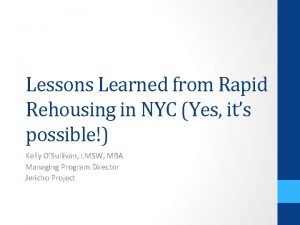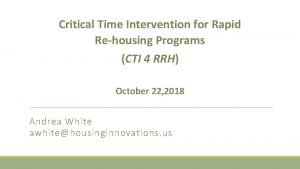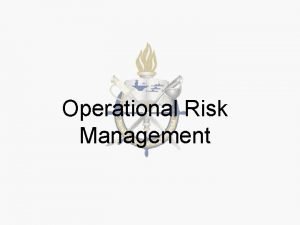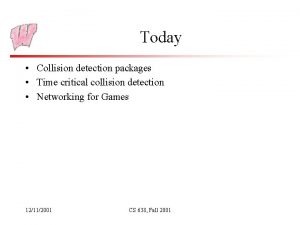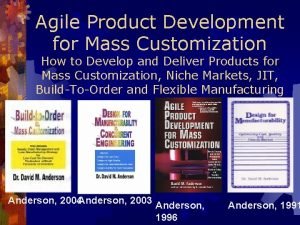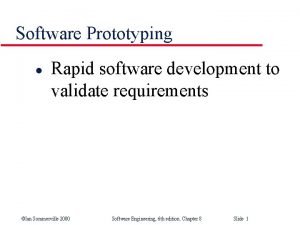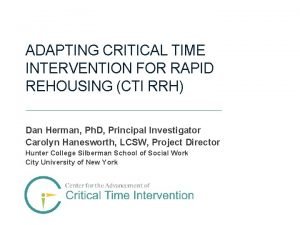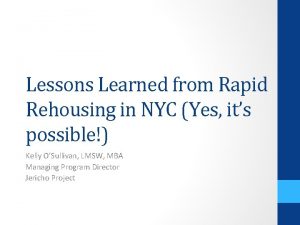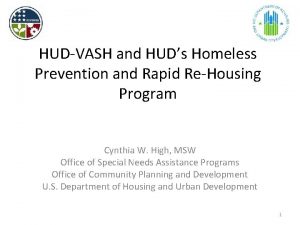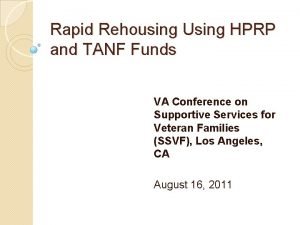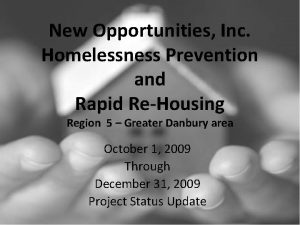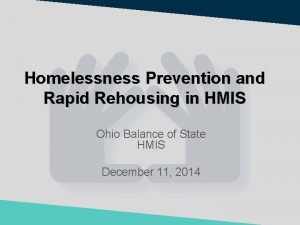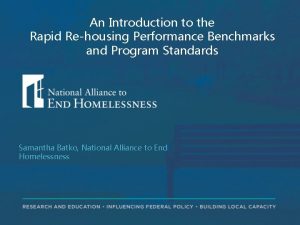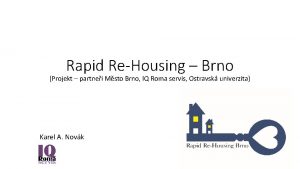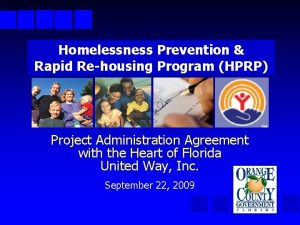Critical Time Intervention and Rapid Rehousing Lessons from



























- Slides: 27

Critical Time Intervention and Rapid Rehousing: Lessons from a Pilot Project in CT NAEH Conference July 2018 Session 4. 05 Suzanne Wagner swagner@housinginnovations. us

Session Overview ◦ Brief CTI Overview ◦ Pilot Study ◦ Lessons from Technical Assistance ◦ Provider Perspective ◦ Q&A 2

Critical Time Intervention (CTI) ◦ Evidence-based practice (EBP) designed to: • Assist vulnerable individuals and families • TRANSITION to housing and community life • Build skills and networks of support ◦ Helps people live successfully in the community and reduce returns to homelessness ◦ Manualized and phased intervention - focused assessment and service planning ◦ Tenancy and life skills, networks of care and support, finances, employment ◦ Role, purpose and structure ◦ Incorporates “Supporting EBP’s” 3

CTI in RRH Overview Focused on housing stability and achieving goals • Link housing stability to personal goals Time-limited (6 months) • Other services can (and usually will) continue post 9 months Pre-CTI • Planning/preparing for transition • Important phase - housing planning Three 2 -month phases of decreasing intensity 4 • Phase 1: Transition to community • Phase 2: Try out • Phase 3: Step down/Transfer of care

CTI in RRH Overview – 2 Limited focus – Assessments and Service Plans Interventions focus on preventing/resolving threats to housing stability and achieving goals Connections to community resources 5 • 1 -3 goals in in specified assessment domains • Meeting lease obligations • Increasing income • Following community norms and expectations • Develop network of supports/linkages and adjust • Connect to natural supports

Key Model Characteristics ◦ Time limited ◦ Three phases ◦ Decreasing contact ◦ Highly focused ◦ Small weighted caseload ◦ Community based ◦ Weekly team supervision

◦ Strengths-based ◦ Individualized ◦ Culturally sensitive ◦ Transparent ◦ Trauma-informed

Core Components of Rapid Rehousing: Where does CTI fit? Rental & Move In Assistance Case Management Services (CTI Housing Identification Quick Exit and Return to Permanent Housing

CRITICAL TIME INTERVENTION IN RAPID REHOUSING PILOT STUDY Dan Herman, Ph. D, Principal Investigator Carolyn Hanesworth, LCSW, Project Director Hunter College Silberman School of Social Work City University of New York

CTI for Rapid Rehousing Pilot Study Why embark on this project? Case management strategies for RRH recipients vary widely across the country; There is a lack of data describing or evaluating effective case management strategies Study Purpose: To provide a standardized best practice model for use with RRH to be employed across multiple settings, populations and locations

Background • CTI was originally developed to assist individuals during a period of transition between homelessness and permanent housing. • CTI emphasizes maintaining continuity of care while gradually passing primary responsibility to supports in the community. • Research has found the model to be effective for many different populations; this is the first attempt to formally adapt for the RRH recipients

Pilot Study • January 2016 - ongoing • Partners: CCEH, The Melville Charitable Trust, NAEH, CT DOH, Center to Advance Critical Time Intervention at CUNY, Provider agencies in CT, Housing Innovations • Literature Review • Model Development • Training and Implementation • Technical Assistance • Fidelity Reviews (current stage)

Model Development Continuing • Still learning- Fidelity Reviews will bring critical information about: • Challenges to implementation for agencies (capacity/resources/culture) • The timeframe for CTI- 6 months • What work, what doesn’t • Differences between large and small organizations, urban vs. rural, different housing markets

Very Early Lessons from Fidelity Review • Positive feedback about the structure of the model • Supervision is critical • Pre-CTI phase is critical, and can really improve outcomes • There is a learning curve- if there isn’t consistent supervision/training its is easy to slip back into old ways of doing things.

CTI 4 RRH Lessons from Technical Assistance Andrea White awhite@housinginnovations. us

Structure of the TA ◦ Series of full-day trainings over course of the project ◦ Written resources, video and website ◦ Monthly Communities of Practice --- Bi Monthly at 6 months ◦ Monthly Agency Consultation Calls --- Bi Monthly at 6 months ◦ All staff participate, including supervisory staff ◦ Fully Integrate Secure Jobs 16

Strengths of Teams ◦ Committed to the population ◦ Using Coordinated Entry System resources including resources to help people get document ready ◦ Problem-solving approach ◦ Team members willing to share resources and expertise ◦ Organized supervision structure 17

Implementation Challenges Prioritizing time with participants after housed ◦ Implementing weighted case loads; weight for pre-CTI ◦ Decreasing case loads for Family Providers Moving through the phases ◦ Focus on time line and phase-tracking ◦ Looking at movement ◦ Defining financial expectations ◦ Considering other options besides one household one house ◦ Looking at techniques used in diversion program to broaden option of housing stability ◦ Transitional Services rather than Long Term Case Management ◦ Developing Networks of Care 18

Problem-Solving Identifying and using networks of care ◦ Using teams to identify resources ◦ Advocacy resources to address system resources such as child care Provide training and consultation on motivation techniques and skill building ◦ Structure in “warm handoff” with network of care and landlords ◦ Ensure weighted case load is employed so that time is available to do skill building and help with connections ◦ Functional separation of landlord and services roles Focus on Long Term Stabilization ◦ Teach tenancy skills ◦ Establish predictable process to take over rent 19

◦ Three levels of TA evolved into: ◦ skill building in the training, ◦ peer support and structure of the program in the COP and ◦ individual successes and challenges in the calls Lessons Learned ◦ Teams at different levels so topics were different. ◦ All teams improved and were able to identify value in the intervention. ◦ Case conferencing was most useful in the individual calls ◦ Tools had to be developed: guide to phase 3 step down, FAQs, talking points for CTI with public and clients, crisis planning and fidelity self assessment. ◦ Identifying alternate successful paths was difficult and took time to develop. ◦ This was further complicated by having participants who scored for PSH and had long term case management needs. ◦ Access to secure jobs was invaluable ◦ Housing location took time away from CTI work ◦ Identify, separate out and address system challenges 20

Provider Perspective

How is CTI Working with RRH? Benefits: • It’s a good fit. Time limited case work for a time limited rental assistance program • Manageable case loads with regular transition • A focus on linking clients with the resources and skills they need to succeed without ongoing case management or financial assistance • Clients respond better to separation from services and rental assistance

Challenges • None of the challenges we faced were insurmountable and each of them got better over time. • There are strategies that can be used to reduce incidents inherent to implementation difficulties.

Challenges & How We Overcame Them CTI Workers/Supervisors holding to traditional case management * The change in mindset is often very challenging. This can be addressed by having: • • A committed direct supervisor with solid understanding of CTI Principles Weekly Team Supervision Frequent Individual Supervision Full CTI Training and regular follow up/refreshers * Overtime it does get better.

Challenges & How We Overcame Them Community, and Client expectation of traditional "Case Management” “Your case manager isn’t doing her job!” • Educate clients and partners from the beginning with handout’s, brochures, presentations etc. • Do not refer to CTI as Case Management. It is not. - Utilize other names such as interventionist, liaison, specialist, worker, etc. - Point out that this is a different model than what they are used to • Keep at it. Overtime partners and clients will come around

Challenges & How We Overcame Them Discharging clients after just 6 months • Many CTI staff will often struggle with “letting clients go” or not being the “go-to person”. • Client situation sometimes necessitate prolonging services Ø Solutions • • • Clients do not have to be “Stable” to be discharged. Most won’t be. Reframe “success” Work from day one to establish support systems and linkages Step down visits and turn over responsibility Establish a support system discharge plan On rare occasions extension of case work is indicated. Must be the exception not the rule

Challenges & How We Overcame Them Combining RRH with CTI • Combining Services with Rental Assistance - Gaining the trust of clients when full disclosure could lead to increase in rental portions or termination of rental assistance. • Additional processes, meetings, tracking and paperwork for RRH and CTI - Initially difficult but if done well, benefits become apparent - Work flows, procedure manuals, utilization of tracking tools can minimize confusion and difficulty.
 Rapid rehousing omaha
Rapid rehousing omaha Rapid rehousing pierce county
Rapid rehousing pierce county Rapid rehousing nyc
Rapid rehousing nyc Critical semi critical and non critical instruments
Critical semi critical and non critical instruments Spaulding classification
Spaulding classification Critical time intervention training
Critical time intervention training Start time, end time and elapsed time
Start time, end time and elapsed time Compare non-critical readers with critical readers.
Compare non-critical readers with critical readers. Extra rapid hardening cement setting time
Extra rapid hardening cement setting time 6-5 study guide and intervention rhombi and squares
6-5 study guide and intervention rhombi and squares Tcrm abcd process
Tcrm abcd process Time-critical packages
Time-critical packages What are the 5 steps of orm?
What are the 5 steps of orm? Critical clearing time
Critical clearing time Power angle
Power angle Power world
Power world The shunammite woman
The shunammite woman Leadership lessons from elijah and elisha
Leadership lessons from elijah and elisha Lessons 3 and 4 personal relationships
Lessons 3 and 4 personal relationships Leviticus 10 lesson
Leviticus 10 lesson Lessons from david and goliath
Lessons from david and goliath Chapter 6 quiz 1 lessons 6-1 and 6-2 answers
Chapter 6 quiz 1 lessons 6-1 and 6-2 answers Suffixes ful and less lessons
Suffixes ful and less lessons Srrt team
Srrt team Double pot method of water purification
Double pot method of water purification Mass customization and rapid product development
Mass customization and rapid product development Rapid prototyping software development
Rapid prototyping software development Panoramic survey telescope and rapid response system
Panoramic survey telescope and rapid response system


